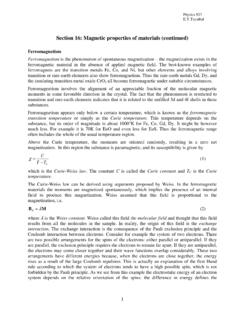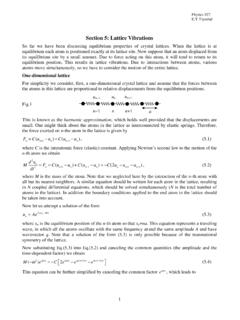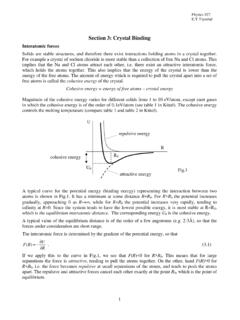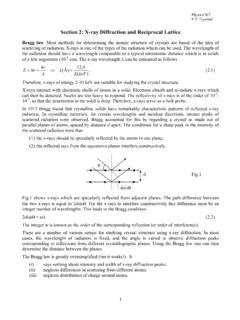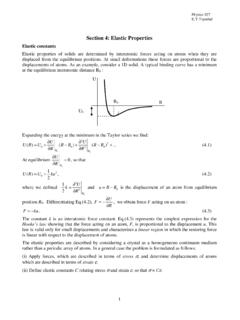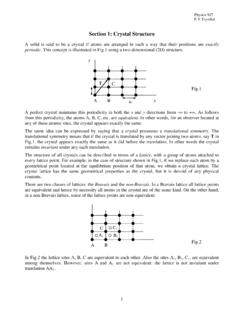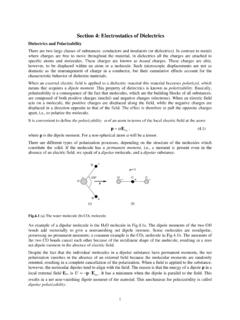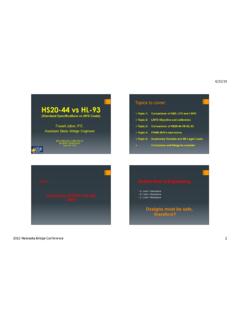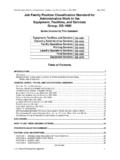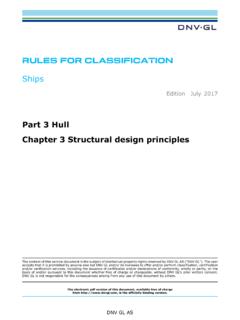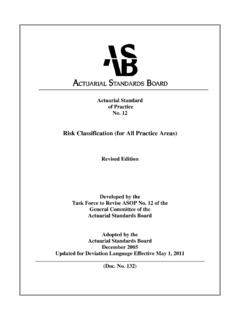Transcription of Section 15: Magnetic properties of materials
1 Physics 927 1 Section 15: Magnetic properties of materials definition of fundamental quantities When a material medium is placed in a Magnetic field, the medium is magnetized. This magnetization is described by the magnetization vector M, the dipole moment per unit volume. Since the magnetization is induced by the field, we may assume that M is proportional to H. That is, =MB. (1) The proportionality constant is known as the Magnetic susceptibility of the medium. Note that the Magnetic susceptibility bears no physical relationship to the electric susceptibility, although the same symbol is used for both. Note also that our discussion assumes that the medium is magnetically isotropic. But real crystals are anisotropic, and the susceptibility is represented by a second-rank tensor. In order to avoid mathematical complications, however, we shall ignore anisotropic effects in our treatment.
2 Note, that in Eq. (1) we assumed that M is proportional to B, the external field, and in doing so we ignored such things as demagnetization field, which were included in the electric case. The neglect of these factors is justifiable in the case of paramagnetic and diamagnetic materials because M is very small compared to B (typically 5/~ 10 =BM), unlike the electric case, in which ~ 1. But when we deal with ferromagnetic materials , where M is quite large, this omission is no longer tenable, and the above effects must be included. Because of small value of the Magnetic susceptibility we will not make distinction between Magnetic field and Magnetic induction. Note also that in Eq.(1) can be dependent on the applied Magnetic field. In this case, we can define the Magnetic susceptibility as follows MB = . (2) The magnetization can be defined as EMB = , (3) where E is the total energy of the system.
3 Definitions (2) and (3) are more general and can be used in calculations. Classification of materials All Magnetic materials may be grouped into three Magnetic classes, depending on the Magnetic ordering and the sign, magnitude and temperature dependence of the Magnetic susceptibility. We will discuss properties of five classes of materials : diamagnetic, paramagnetic, ferromagnetic, antiferromagnetic and ferrimagnetic. There is no Magnetic order at any temperature in diamagnetic and paramagnetic materials , whereas there is a Magnetic order at low temperatures in ferromagnetic, antiferromagnetic and ferrimagnetic materials . Physics 927 2 In diamagnetic materials the Magnetic susceptibility is negative. Usually its magnitude is of the order of -10-6 to -10-5. The negative value of the susceptibility means that in an applied Magnetic field diamagnetic materials acquire the magnetization, which is pointed opposite to the applied field.
4 In diamagnetic materials the susceptibility nearly has a constant value independent of temperature. Ionic crystals and inert gas atoms are diamagnetic. These substances have atoms or ions with complete shells, and their diamagnetic behavior is due to the fact that a Magnetic field acts to distort the orbital motion. Another class of diamagnetic materials is noble metals. All the other classes of materials have positive susceptibility. Within these classes the magnitude of the susceptibility varies over a very wide range. However, at sufficiently high temperatures the susceptibility decreases with increasing temperature for all materials in these classes. It was found experimentally that all these materials follow the relationship CCTT = (4) more or less exactly for sufficiently high T. Here C and TC are positive constants independent of temperature and different for each material.
5 It was found that in some materials TC=0 and this equation is obeyed down to the lowest temperatures at which measurements have been made. This class of materials is called paramagnetic. In paramagnetic materials is positive - that is, for which M is parallel to B. The susceptibility is however is also very small: 10-4 to 10-5. The best-known examples of paramagnetic materials are the ions of transition and rare-earth ions. The fact that these ions have incomplete atomic shells is what is responsible for their paramagnetic behavior. In all other materials equation (4) breaks down as temperature decreases. They all have a critical temperature below which the variation of susceptibility with temperature is very different from its variation above this temperature. In ferromagnetic materials the critical temperature is called the Curie temperature.
6 Above the Curie temperature the susceptibility follow relationship (4) with a negative sign. When temperature approaches TC the Magnetic susceptibility tends to be infinite. An infinite susceptibility means that a finite magnetization can exist even in zero applied field, which is the case in permanent magnets. The problem is that the magnetization of ferromagnetic materials in zero field can have a range of different values and consequently cannot be regarded as a property of the material. However, it is found that if a relatively small Magnetic field is applied to these materials , the magnetization tends to a constant value, which is called the saturation magnetization MS or spontaneous magnetization. Below Curie temperature MS(T) against T follows a universal curve: it tends to a constant value as T=0; as T increases, the spontaneous magnetization decreases more and more rapidly.
7 At the Curie temperature the magnetization disappeared. Ferrimagnetic materials have non-zero magnetization below the Curie temperature which is similar to ferromagnetic materials . However, significant departures from (4) occur over a range of temperatures. This behaviour is only followed at temperatures large compared with the Curie temperature. Another difference between ferrimagnets and ferromagnets is that in ferrimagnetic materials the saturation magnetization against temperature behave in a more complicated way. For Physics 927 3 example, for some ferrimagnets the magnetization can increase with increasing temperature and then drops down. Antiferromagnetic materials have small positive susceptibilities at all temperatures. At high temperatures they follow eq. (4) with TC usually having a positive sign. A critical temperature in this case is called Neel temperature.
8 Below the Neel temperature the susceptibility generally decreases with decreasing temperature. There is no spontaneous magnetization in antiferromagnetic materials . Calculation of atomic susceptibilities In the presence of a uniform Magnetic field the Hamiltonian of an ion (atom) is modified in the two major ways: (1) In the total kinetic energy term the momentum of each electron is replaced by ec +ppA, (5) where A is the vector potential associated with the Magnetic field such that = B A. (6) We assume that the applied field is uniform so that 12= Ar B. (7) (2) The interaction energy of the field with each electron spin must be added to the Hamiltonian: 2spinBH =BS, (8) where B is the Bohr magneton 10/2 BeeVGmc == . (9) As the result the total energy of electrons will have a form 21222iiBieHmc = + pr BBS. (10) We denote by T0 the kinetic energy in the absence of the applied field, 2012iiTm= p.
9 (11) The cross term is the brackets can be rewritten taking into account that ()()iiii = pr BBr p. (12) We note that also r and p are quantum-mechanical operators, here we can work with these quantities as with classical variables because only non-diagonal components enter this product ( Physics 927 4 there no terms which contain, , x components of both r and p which do not commute). Note: ,rpi = . Assuming that the field is along z direction, we can rewrite ()()2222iiiBxy=+r B. (13) Finally we find for the field-dependent correction to the total Hamiltonian: ()222202(2)8 BiiieHHTB xymc ==+ ++ LSB , (14) where L is the total orbital momentum: ()iii= Lr p . (15) The energy correction due to the applied electric field is small compared to electron energies. For example, 1T= 10 BTeslaeV = . Therefore one can compute the changes in the energy levels induced by the field with ordinary perturbation theory.
10 Equation (14) is the basis for theories of the Magnetic susceptibility of individual atoms, ions, or molecules. Langevin diamagnetism Let us now apply these results to a solid composed of ions or atoms with all electronic shells filled. Such atoms have zero spin and orbital angular momentum in its ground state, 00000==SL. (16) Consequently only last term in eq.(14) contributes to the field-induced shift in the ground state energy: ()222222222000000812iiiiieeEHBxyBrmcmc== += , (17) where the last form follows from the spherical symmetry of the closed-shell ion, 22221300000000iiiiiiiixyzr=== . (18) It is conventional to define a mean square ionic radius by 22100iirrZ= , (19) where Z is the total number of electrons in an ion. We obtain then for the magnetization induced by the applied Magnetic field, according to (3): Physics 927 5 2226e NZrEMBBmc = = , (20) which implies a negative Magnetic susceptibility: 2226e NZrmc = , (21) where N is the number of atoms per unit volume.
